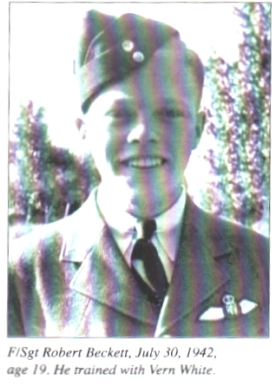Royal Air Force Ferry Command, Dorval, Quebec
The next day we left for Montréal and two days later pulled into a siding near the Lachine Manning Depot where we were to be billeted. The good news kept getting better. Being attached to the RAF, and no living quarters at Dorval, we received an additional $3.00 per day (later reduced to $2.70) living-out allowanc. At Lachine we were charged something like $.50 a day by the RCAF for food and lodging. So it was like having a license to print money.
The following morning we were taken by bus to Dorval, a distance of about 3 miles. On arrival we were greeted by a Squadron Leader who informed that this being a Friday there would be nothing doing until Monday. We could have a 48 hour pass if we would perform a task for the Ferry Command CO. There was a funeral that afternoon for two Australians and an RAF officer who had crashed on the west end of the island a few days before. There was to be a funeral procession along Sherbrooke Street in downtown Montréal, followed by burial in Mont Royal Cemetery. Two Canadians in the crew were also killed and were to be buried in their home towns (their names were McGinnis and Burton-Murphy). None of us had done the slow march since our training days at I.T.S. and then only a few times. There was nothing to do but practice, and practice we did for two solid hours. We were bussed to Montréal and 50 air observers comprised the ceremonial contingent. The parade went off without any major foul-ups and I remember thinking how sad that the final resting place of these airmen were so far from home.
I had already wired my folks that I would be remaining in Canada for a while but they had no idea I would be having a leave so soon. I had a nice weekend at home and the whole neighborhood was surprised to see me; they thought I was on the high seas. They got used to seeing me around as I was home four weekends in the next two months.
At Dorval we were told that our duties would be light and there were true to their word. There was ground school training in the mornings with most afternoons and every evening off. Ferry Command was a busy place and the variety of military aircraft coming and going was awesome, to use a modern expression. There were Hudsons, Venturas, Mitchells, Liberators and other American aircraft destined for Europe. They were flown mostly by American civilian pilots and for each overseas flight they were paid handsomely. The wireless operators and navigators were RCAF or from one of the Commonwealth air forces. After the flight to Britain the ferry pilots were flown back to Canada to repeat the process. The military aircrew would normally remain in Britain and be posted to a unit as if they had come by ship. We received some useful training at Dorval especially learning about radio beacons in Labrador, Greenland, Icsland and Scotland. There was also to be one cross-country flight to test our navigation capability.
